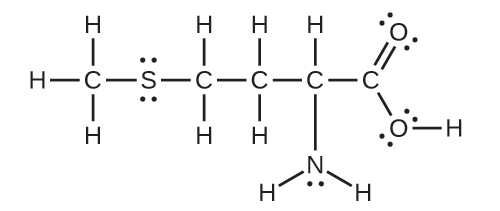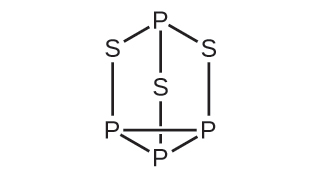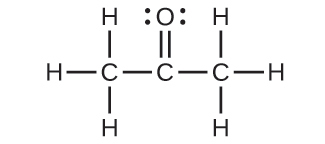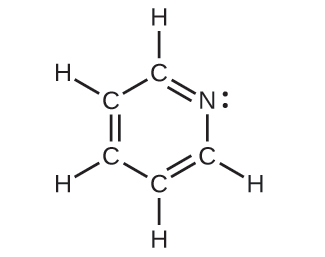Chapter 8 Advanced Theories of Covalent Bonding
Chapter 8 Problems
8.1 Valence Bond Theory
8.1. Explain how σ and π bonds are similar and how they are different.
8.2. Draw a curve that describes the energy of a system with H and Cl atoms at varying distances. Then, find the minimum energy of this curve two ways.
(a) Use the bond energy found in Table 8.1 to calculate the energy for one single HCl bond (Hint: How many bonds are in a mole?)
(b) Use the enthalpy of reaction and the bond energies for H2 and Cl2 to solve for the energy of one mole of HCl bonds.
H2(g) + Cl2(g) ⇌ 2 HCl(g) ΔH° = −184.7kJ/mol
8.3. Explain why bonds occur at specific average bond distances instead of the atoms approaching each other infinitely close.
8.4. Use valence bond theory to explain the bonding in F2, HF, and ClBr. Sketch the overlap of the atomic orbitals involved in the bonds.
8.5. Use valence bond theory to explain the bonding in O2. Sketch the overlap of the atomic orbitals involved in the bonds in O2.
8.6. How many σ and π bonds are present in the molecule HCN?
8.7. A friend tells you N2 has three π bonds due to the overlap of the three p-orbitals on each N atom. Do you agree?
8.8. Draw the Lewis structures for CO2 and CO, and predict the number of σ and π bonds for each molecule.
(a) CO2
(b) CO
8.2 Hybrid Atomic Orbitals
8.9. Why is the concept of hybridization required in valence bond theory?
8.10. Give the shape that describes each hybrid orbital set:
(a) sp2
(b) sp3d
(c) sp
(d) sp3d 2
8.11. Explain why a carbon atom cannot form five bonds using sp3d hybrid orbitals.
8.12. What is the hybridization of the central atom in each of the following?
(a) BeH2
(b) SF6
(c) PO43−
(d) PCl5
8.13. A molecule with the formula AB3 could have one of four different shapes. Give the shape and the hybridization of the central A atom for each.
 8.14. Methionine, CH3SCH2CH2CH(NH2)CO2H, is an amino acid found in proteins. The Lewis structure of this compound is shown below. What is the hybridization type of each carbon, oxygen, the nitrogen, and the sulfur?
8.14. Methionine, CH3SCH2CH2CH(NH2)CO2H, is an amino acid found in proteins. The Lewis structure of this compound is shown below. What is the hybridization type of each carbon, oxygen, the nitrogen, and the sulfur?
8.15. Sulfuric acid is manufactured by a series of reactions represented by the following equations:
S8(s) + 8 O2(g) → 8 SO2(g)
Draw a Lewis structure, predict the molecular geometry by VSEPR, and determine the hybridization of sulfur for the following:
(a) circular S8 molecule
(b) SO2 molecule
(c) SO3 molecule
(d) H2SO4 molecule (the hydrogen atoms are bonded to oxygen atoms)
8.16. Two important industrial chemicals, ethene, C2H4, and propene, C3H6, are produced by the steam (or thermal) cracking process:
2 C3H8(g) → C2H4(g) + C3H6(g) + CH4(g) + H2(g)
For each of the four carbon compounds, do the following:
(a) Draw a Lewis structure.
(b) Predict the geometry about the carbon atom.
(c) Determine the hybridization of each type of carbon atom.
8.17. Analysis of a compound indicates that it contains 77.55% Xe and 22.45% F by mass.
(a) What is the empirical formula for this compound? (Assume this is also the molecular formula in responding to the remaining parts of this exercise.)
(b) Write a Lewis structure for the compound.
(c) Predict the shape of the molecules of the compound.
(d) What hybridization is consistent with the shape you predicted?
8.18. Consider nitrous acid, HNO2 (HONO).
(a) Write a Lewis structure.
(b) What are the electron pair and molecular geometries of the internal oxygen and nitrogen atoms in the HNO2 molecule?
(c) What is the hybridization on the internal oxygen and nitrogen atoms in HNO2?
 8.19. Strike-anywhere matches contain a layer of KClO3 and a layer of P4S3. The heat produced by the friction of striking the match causes these two compounds to react vigorously, which sets fire to the wooden stem of the match. KClO3 contains the ClO3− ion. P4S3 is an unusual molecule with the skeletal structure.
8.19. Strike-anywhere matches contain a layer of KClO3 and a layer of P4S3. The heat produced by the friction of striking the match causes these two compounds to react vigorously, which sets fire to the wooden stem of the match. KClO3 contains the ClO3− ion. P4S3 is an unusual molecule with the skeletal structure.
(a) Write Lewis structures for P4S3 and the ClO3– ion.
(b) Describe the geometry about the P atoms, the S atom, and the Cl atom in these species.
(c) Assign a hybridization to the P atoms, the S atom, and the Cl atom in these species.
(d) Determine the oxidation states and formal charge of the atoms in P4S3 and the ClO3– ion.
8.20. Identify the hybridization of each carbon atom in the following molecule. (The arrangement of atoms is given; you need to determine how many bonds connect each pair of atoms.)
8.21. Write Lewis structures for NF3 and PF5. On the basis of hybrid orbitals, explain the fact that NF3, PF3, and PF5 are stable molecules, but NF5 does not exist.
8.22. In addition to NF3, two other fluoro derivatives of nitrogen are known: N2F4 and N2F2. What shapes do you predict for these two molecules? What is the hybridization for the nitrogen in each molecule?
8.3 Multiple Bonds
8.23. The bond energy of a C–C single bond averages 347 kJ/mol; that of a C≡C triple bond averages 839 kJ/mol. Explain why the triple bond is not three times as strong as a single bond.
8.24. For the carbonate ion, CO32−, draw all of the resonance structures. Identify which orbitals overlap to create each bond.
8.25. A useful solvent that will dissolve salts as well as organic compounds is the compound acetonitrile, H3CCN. It is present in paint strippers.
(a) Write the Lewis structure for acetonitrile, and indicate the direction of the dipole moment in the molecule.
(b) Identify the hybrid orbitals used by the carbon atoms in the molecule to form σ bonds.
(c) Describe the atomic orbitals that form the π bonds in the molecule. Note that it is not necessary to hybridize the nitrogen atom.
8.26. For the molecule allene, H2C=C=CH2, give the hybridization of each carbon atom. Will the hydrogen atoms be in the same plane or perpendicular planes?
8.27. When drawing Lewis structures, remember that the least electronegative atom will go in the center.
8.28. Describe the molecular geometry and hybridization of the N, P, or S atoms in each of the following compounds.
(a) H3PO4, phosphoric acid, used in cola soft drinks
(b) NH4NO3, ammonium nitrate, a fertilizer and explosive
(c) S2Cl2, disulfur dichloride, used in vulcanizing rubber
(d) K4[O3POPO3], potassium pyrophosphate, an ingredient in some toothpastes
8.29.
8.30. For each of the following structures, determine the hybridization requested and whether the electrons will be delocalized:
(a) Hybridization of each carbon
(b) Hybridization of sulfur
(c) All atoms
8.31. Draw the orbital diagram for carbon in CO2 showing how many carbon atom electrons are in each orbital.
8.4 Molecular Orbital Theory
8.32. Sketch the distribution of electron density in the bonding and antibonding molecular orbitals formed from two s orbitals and from two p orbitals.
8.33. How are the following similar, and how do they differ?
(a) σ molecular orbitals and π molecular orbitals
(b) ψ for an atomic orbital and ψ for a molecular orbital
(c) bonding orbitals and antibonding orbitals
8.34. If molecular orbitals are created by combining five atomic orbitals from atom A and five atomic orbitals from atom B combine, how many molecular orbitals will result?
8.35. Can a molecule with an odd number of electrons ever be diamagnetic? Explain why or why not.
8.36. Can a molecule with an even number of electrons ever be paramagnetic? Explain why or why not.
8.37. Why are bonding molecular orbitals lower in energy than the parent atomic orbitals?
8.38. Calculate the bond order for an ion with this configuration:
(σ2s)2(σ2s*)2(σ2px)2(π 2py, π 2pz)4(π 2py*, π 2pz*)3
8.39. Explain why an electron in the bonding molecular orbital in the H2 molecule has a lower energy than an electron in the 1s atomic orbital of either of the separated hydrogen atoms.
8.40. Predict the valence electron molecular orbital configurations for the following, and state whether they will be stable or unstable ions.
(a) Na22+
(b) Mg22+
(c) Al22+
(d) Si22+
(e) P22+
(f) S22+
(g) F22+
(h) Ar22+
8.41.
8.42. For the first ionization energy for an N2 molecule, what molecular orbital is the electron removed from?
8.43.
8.44. Which of the period 2 homonuclear diatomic molecules are predicted to be paramagnetic?
8.45. A friend tells you that the 2s orbital for fluorine starts off at a much lower energy than the 2s orbital for lithium, so the resulting σ2s molecular orbital in F2 is more stable than in Li2. Do you agree?
8.46. True or false: Boron contains 2s22p1 valence electrons, so only one p orbital is needed to form molecular orbitals.
8.47.
8.48. Predict whether the MO diagram for S2 would show s-p mixing or not.
8.49. Explain why N22+ is diamagnetic, while O24+, which has the same number of valence electrons, is paramagnetic.
8.50. Using the MO diagrams, predict the bond order for the stronger bond in each pair:
(a) B2 or B2+
(b) F2 or F2+
(c) O2 or O22+
(d) C2+ or C2−
Cumulative
8.51.




